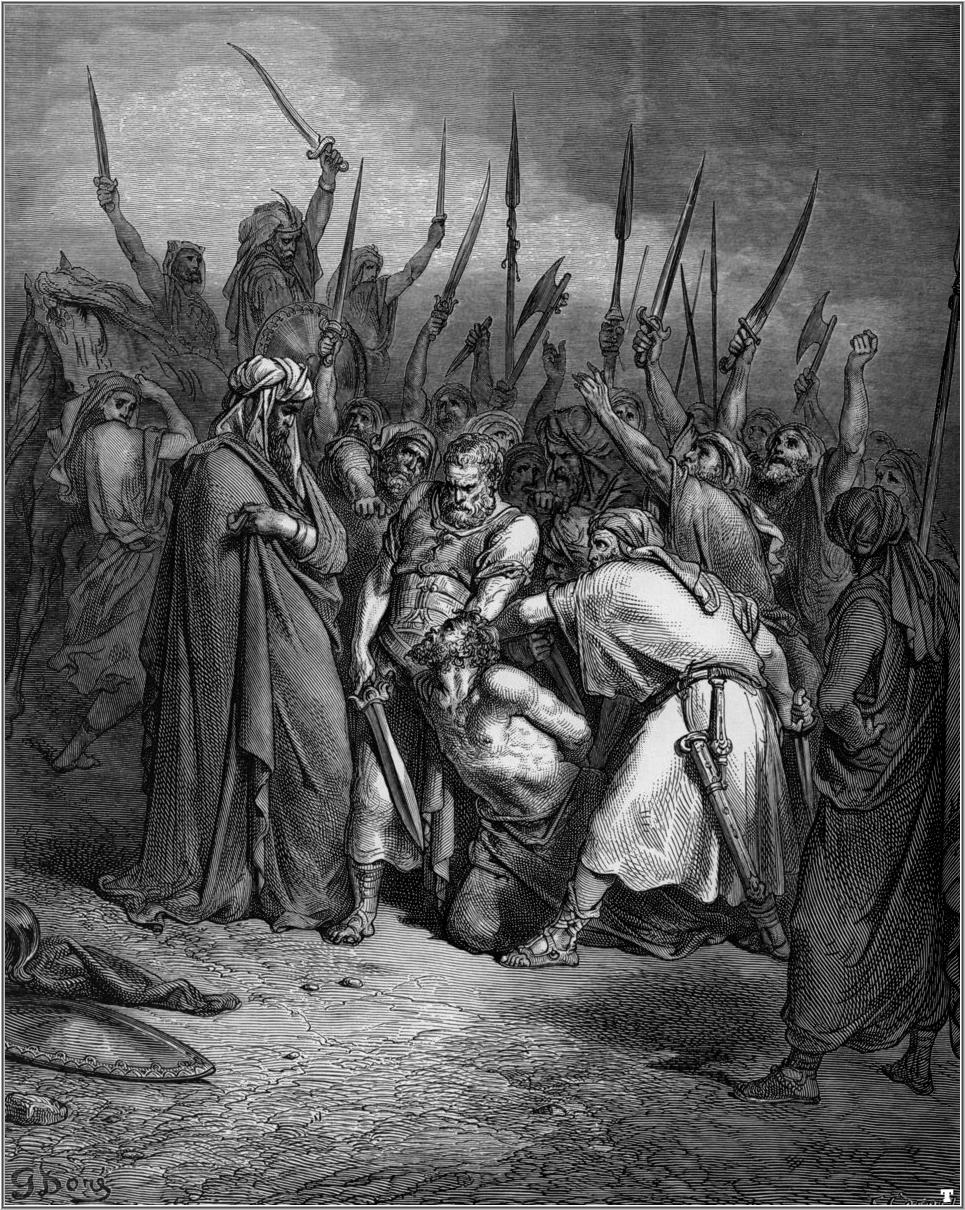|
Agagite
The term Agagite is used in the Book of Esther as a description of Haman. The term is understood to be an ethnonym although nothing is known with certainty about the people designated by the name. According to Cheyne and Black, this term is used to label Haman, figuratively, as a "descendant" of Agag, the enemy of Israel and king of the Amalekites.Cheyne and Black (1899), ''Encyclopaedia Biblica,'' entry for "Agagite./ref> "Haman, as an Amalekite, is opposed to Mordecai, the descendant of Kish (Esth r2:5) ... The meaning is that there is an internecine struggle between the Jews and their enemies, like that between Saul and Agag of old." With this understanding, the Greek translator rendered the term "Macedonian." A well known Midrashic explanation of the term relates it to King Agag of the Amalekites whereby it is viewed as meaning either a literal descendant of Agag or a symbolic term for an antisemite Antisemitism (also spelled anti-semitism or anti-Semitism) is hostilit ... [...More Info...] [...Related Items...] OR: [Wikipedia] [Google] [Baidu] |
Haman (Bible)
Haman ( ; also known as Haman the Agagite or Haman the evil) is the main antagonist in the Book of Esther, who according to the Hebrew Bible was an official in the court of the Persian empire under King Ahasuerus, commonly identified as Xerxes I (died 465 BCE) but traditionally equated with Artaxerxes I or Artaxerxes II. As his epithet ''Agagite'' indicates, Haman was a descendant of Agag, the king of the Amalekites. Some commentators interpret this descent to be symbolic, due to his similar personality. Retrieved 13 February 2017 Etymology and meaning of the name The name has been equated with the Persian name ''Omanes''Encyclopaedia Judaica CD-ROM Edition 1.0 1997, ''Haman'' ( peo, 𐎡𐎶𐎴𐎡𐏁, ) recorded by Greek historians. Several etymologies have been proposed for it: it has been associated with the Persian word , meaning "illustrious" (naming dictionaries typically list it as meaning "magnificent"); with the sacred drink Haoma; or with the Persian name Vohuman, me ... [...More Info...] [...Related Items...] OR: [Wikipedia] [Google] [Baidu] |
Book Of Esther
The Book of Esther ( he, מְגִלַּת אֶסְתֵּר, Megillat Esther), also known in Hebrew language, Hebrew as "the Scroll" ("the wikt:מגילה, Megillah"), is a book in the third section (, "Writings") of the Judaism, Jewish ''Tanakh'' (the Hebrew Bible). It is one of the five Scrolls () in the Hebrew Bible and later became part of the Christian Old Testament. The book relates the story of a Israelites, Hebrew woman in Achaemenid Empire, Persia, born as Hadassah but known as Esther, who becomes queen of Persia and thwarts a genocide of her people. The story forms the core of the Jewish festival of Purim, during which it is read aloud twice: once in the evening and again the following morning. The books of Esther and Song of Songs are the only books in the Hebrew Bible that do not mention God in Judaism, God. Setting and structure Setting The biblical Book of Esther is set in the Persian Capital city, capital of Susa (''Shushan'') in the third year of the reign ... [...More Info...] [...Related Items...] OR: [Wikipedia] [Google] [Baidu] |
Agag
Agag (; he, אֲגַג ''ʾĂgāg'') is a Northwest Semitic name or title applied to a biblical king. It has been suggested that "Agag" was a dynastic name of the kings of Amalek, just as Pharaoh was used as a dynastic name for the ancient Egyptians. The etymology is uncertain, according to John L. McKenzie (1995), while Cox (1884) suggested "High." In the Torah, the expression "Its king higher than Agag, and its kingdom exalted" was uttered by Balaam in Numbers 24:7, in his third prophetic utterance, to describe a king of Israel who would be higher than the king of Amalek. This is understood to mean that Israel's king would take a higher position than even Amalek himself, and would exercise a wider authority. The writer uses an allusion to the literal significance of the word "Agag", meaning "high", to convey that the king of Israel would be "higher than High". A characteristic trait of biblical poetry is to use puns. Agag also refers to the Amalekite king who survived King S ... [...More Info...] [...Related Items...] OR: [Wikipedia] [Google] [Baidu] |
Ethnonym
An ethnonym () is a name applied to a given ethnic group. Ethnonyms can be divided into two categories: exonyms (whose name of the ethnic group has been created by another group of people) and autonyms, or endonyms (whose name is created and used by the ethnic group itself). As an example, the largest ethnic group in Germany is Germans. The ethnonym ''Germans'' is a Latin-derived exonym used in the English language. Conversely, the Germans call themselves the , an endonym. The German people are identified by a variety of exonyms across Europe, such as (French language, French), (Italian language, Italian), (Swedish language, Swedish) and (Polish language, Polish). As a sub-field of anthroponymy, the study of ethnonyms is called ethnonymy or ethnonymics. Ethnonyms should not be confused with demonyms, distinctive terms that designate all people related to a specific territory, regardless of any ethnic, religious, linguistic or some other distinctions that may exist within the ... [...More Info...] [...Related Items...] OR: [Wikipedia] [Google] [Baidu] |
Israel
Israel (; he, יִשְׂרָאֵל, ; ar, إِسْرَائِيل, ), officially the State of Israel ( he, מְדִינַת יִשְׂרָאֵל, label=none, translit=Medīnat Yīsrāʾēl; ), is a country in Western Asia. It is situated on the southeastern shore of the Mediterranean Sea and the northern shore of the Red Sea, and shares borders with Lebanon to the north, Syria to the northeast, Jordan to the east, and Egypt to the southwest. Israel also is bordered by the Palestinian territories of the West Bank and the Gaza Strip to the east and west, respectively. Tel Aviv is the economic and technological center of the country, while its seat of government is in its proclaimed capital of Jerusalem, although Israeli sovereignty over East Jerusalem is unrecognized internationally. The land held by present-day Israel witnessed some of the earliest human occupations outside Africa and was among the earliest known sites of agriculture. It was inhabited by the Canaanites ... [...More Info...] [...Related Items...] OR: [Wikipedia] [Google] [Baidu] |
Amalekites
Amalek (; he, עֲמָלֵק, , ar, عماليق ) was a nation described in the Hebrew Bible as a staunch enemy of the Israelites. The name "Amalek" can refer to the nation's founder, a grandson of Esau; his descendants, the Amalekites; or the territories of Amalek, which they inhabited. Etymology In some rabbinical interpretations, Amalek is etymologised as , 'a people who lick (blood)', but most specialists regard the origin to be unknown. Amalekites in the Hebrew Bible According to the Bible, Amalek was the son of Eliphaz (himself the son of Esau, ancestor of the Edomites) and Eliphaz's concubine Timna. Timna was a Horite and sister of Lotan. Amalek is described as the "chief of Amalek" among the "chiefs of the sons of Esau", from which it is surmised that he ruled a clan or territory named after him. The Amalekites () were considered to be Amalek's descendants through the genealogy of Esau. In the oracle of Balaam Balaam (; , Standard ''Bīlʿam'' Tiberian ''Bīlʿām ... [...More Info...] [...Related Items...] OR: [Wikipedia] [Google] [Baidu] |
Septuagint
The Greek Old Testament, or Septuagint (, ; from the la, septuaginta, lit=seventy; often abbreviated ''70''; in Roman numerals, LXX), is the earliest extant Greek translation of books from the Hebrew Bible. It includes several books beyond those contained in the Masoretic text of the Hebrew Bible as canonically used in the tradition of mainstream Rabbinical Judaism. The additional books were composed in Greek, Hebrew, or Aramaic, but in most cases, only the Greek version has survived to the present. It is the oldest and most important complete translation of the Hebrew Bible made by the Jews. Some targums translating or paraphrasing the Bible into Aramaic were also made around the same time. The first five books of the Hebrew Bible, known as the Torah or the Pentateuch, were translated in the mid-3rd century BCE. The remaining translations are presumably from the 2nd century BCE. The full title ( grc , Ἡ μετάφρασις τῶν Ἑβδομήκοντα, , The Translat ... [...More Info...] [...Related Items...] OR: [Wikipedia] [Google] [Baidu] |
Midrash
''Midrash'' (;"midrash" ''Random House Webster's Unabridged Dictionary''. he, מִדְרָשׁ; or מִדְרָשׁוֹת ''midrashot'') is expansive using a rabbinic mode of interpretation prominent in the . The word itself means "textual interpretation", "study", or " |
Antisemite
Antisemitism (also spelled anti-semitism or anti-Semitism) is hostility to, prejudice towards, or discrimination against Jews. A person who holds such positions is called an antisemite. Antisemitism is considered to be a form of racism. Antisemitism has historically been manifested in many ways, ranging from expressions of hatred of or discrimination against individual Jews to organized pogroms by mobs, police, police forces, or genocide. Although the term did not come into common usage until the 19th century, it is also applied to previous and later anti-Jewish incidents. Notable instances of Persecution of Jews, persecution include the Rhineland massacres preceding the First Crusade in 1096, the Edict of Expulsion from England in 1290, the 1348–1351 persecution of Jews during the Black Death, the History of the Jews in Spain#Massacres and mass conversions of 1391, massacres of Spanish Jews in 1391, the persecutions of the Spanish Inquisition, the Alhambra Decree, expulsion ... [...More Info...] [...Related Items...] OR: [Wikipedia] [Google] [Baidu] |
Hebrew Bible People
Hebrew (; ; ) is a Northwest Semitic languages, Northwest Semitic language of the Afroasiatic languages, Afroasiatic language family. Historically, it is one of the spoken languages of the Israelites and their longest-surviving descendants, the Jews and Samaritans. It was largely preserved throughout history as the main Sacred language, liturgical language of Judaism (since the Second Temple period) and Samaritanism. Hebrew is the only Canaanite languages, Canaanite language still spoken today, and serves as the only truly successful example of a Extinct language, dead language that has been language revitalization, revived. It is also one of only two Northwest Semitic languages still in use, with the other being Aramaic. The earliest examples of written Paleo-Hebrew alphabet, Paleo-Hebrew date back to the 10th century BCE. Nearly all of the Hebrew Bible is written in Biblical Hebrew, with much of its present form in the dialect that scholars believe flourished around the 6th ... [...More Info...] [...Related Items...] OR: [Wikipedia] [Google] [Baidu] |



.jpg)


